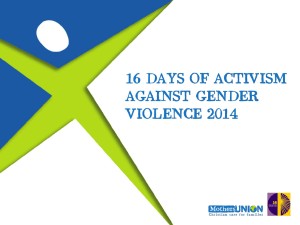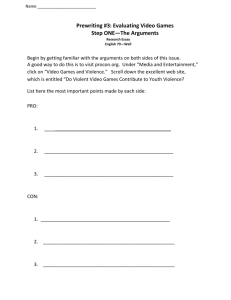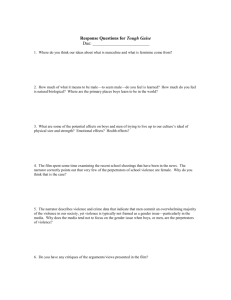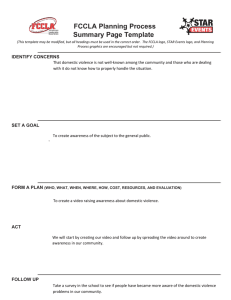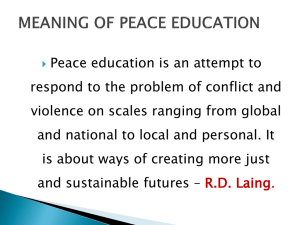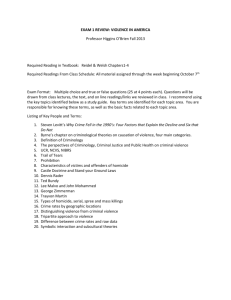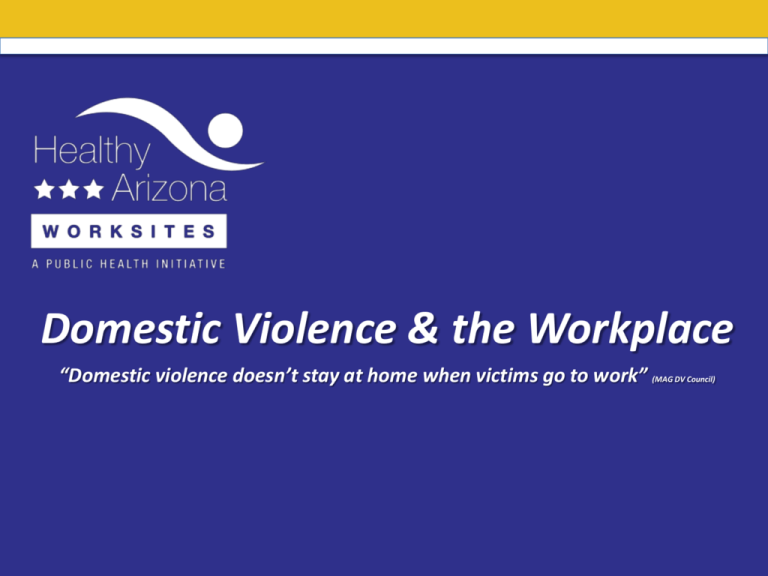
Domestic Violence & the Workplace
“Domestic violence doesn’t stay at home when victims go to work” (MAG DV Council)
Today’s Presenter –
Melody Hicks, MC, LPC
Behavior Health Integration Manager
Maricopa County Public Health Dept.
Today’s Agenda:
How domestic violence affects the workplace
How to recognize warning signs among employees
Methods to address partner violence
Resources for Employers and Employees
“When we think of domestic violence, we typically don’t think about the workplace,
says Alexandra Donovan, violence prevention coordinator at the Cambridge Mass.,
Public Health Department. But we should…because domestic violence has no
boundaries ...”
What Do Employers Think?
According to a Domestic Violence and Mental Health Research Project Report
completed by WestGroup Research and the Healthy Arizona Worksites Program in
2015
• HR Managers feel employers should address Domestic Violence
• HR Managers would like specific policies, procedures, training and other resources to
address Domestic Violence
• HR managers feel that being responsive to employees experiencing Domestic Violence
is very important
• Most employers do not have full picture of how Domestic Violence issues impact their
organizations
A Fortune 100 survey showed that 66% of Senior Executives and 75% of HR directors feel
that if Domestic Violence were addressed the negative impacts (of Domestic Violence)
would greatly improve within their organizations
3
What Would your company do…
Melissa was a high-flying young executive in New York but never
breathing a word to anyone about the Hospital admissions,
miscarriages, beatings all of which had become “normal” in her life.
Fearing she would die, she took an overnight train to California with
only $50 in her pocket and an assumed name she began a new life as a
secretary in an advertising agency.
"If it were not for my employer, I would not be alive today," says
Melissa Morbeck, calmly.
From October 4, 2013 http://www.theguardian.com/sustainable-business/domestic-violence-hidden-workplace-issue
Domestic Violence impacts Workforce Safety & productivity
One in four women and one in seven men will
experience domestic violence in their lifetime.
Center for Disease Control & Prevention
•
Over 1 million women are stalked annually
and at least a quarter of them (250,000)
admit to missing work because of stalking
•
Over half of the employed victims of domestic
violence reported missing work because of
the abuse
•
74% of working, battered women report
being harassed by their partners while at the
workplace
Why talk about Domestic Violence in the Workplace?
6
•
33% of women killed in the workplace
killed by a current or former intimate
partner
•
(1997-2009) on-the-job deaths of 321
women & 38 men were a result of
intimate partner homicide
•
47% of victims of Domestic Violence
are prevented from going to work
Why talk about Domestic Violence in the Workplace?
• A study in Maine in 2003
found that 78% of surveyed
perpetrators used
workplace resources to
check up on, threaten,
pressure their victims
• 21% of offenders reported
contacting their victims at
the workplace even with no
contact orders in place
7
•
Domestic Violence costs $8.3 billion in expenses annually; a combination of higher
medical costs and lost productivity
•
In one 12 month period (2005-2006) 130,000 victims of stalking reported they were asked
to leave their jobs or fired because of stalking
•
Lawsuits filed by injured employees or their estates are costly, averaging $50,000 a case;
with trial cases averaging $3 million a case according to the book, Addressing Domestic
Violence in the Workplace
Interesting Side Note:
The American Institute of Domestic Violence reports that less than half of all victims report their
situation to their supervisors.
More than 70% of all US workplaces do not have a formal program or policy that addresses
Domestic Violence
8
What is Domestic Violence?
According to the U.S. Department of Justice:
Domestic Violence is a pattern of
abusive behavior in any
relationship that is used by one
partner to gain or maintain
power and control over
another intimate partner.
Different Types of Abusive Behavior
• Stalking
• Rape or sexual assault or
abuse
• Physical
• Emotional/Psychological
• Economic
Why Don’t People Just LEAVE?
Red Flags an employee “might” be experiencing
Domestic Violence at home
•
Arriving to work very late or very early
•
Taking time off without notice
•
Decreased productivity
•
Tension around receiving personal phone calls
•
Wearing long sleeves on a hot day or wearing
sunglasses inside
•
Difficulty in making decisions or concentrating
•
Avoiding windows, main entrance to the office
More Warning Signs…
•
Repeated discussion of marital or
relationship problems
•
Flowers or gifts sent to employee
at the workplace for no apparent
reason
•
Bruises, chronic headaches,
abdominal pains, muscle aches
•
Taking frequent time off for
“illnesses” or to see the doctor
•
Fatigue
•
Intense startle reactions
What Can Employers Do?
• Start the Conversation
• Form a group,
committee, or task force
-Create or utilize a survey
for your workforce
What Can Employers Do?
• Provide Training to
Managers & Supervisors
• Build Awareness among
employees about Domestic
Violence
• Offer counseling services
through an Employee
Assistance Programs (EAP)
What Can Employers Do?
• Choose Health Plans
with Domestic Violence
services, including
counseling
• Create policies and
procedures
• Create partnerships
with local shelters
Examples of what some companies have done to incorporate
Domestic Violence awareness in their companies and increase
openness for all employees.
This information comes from the Corporate Alliance to End Partner Violence:
http://www.caepv.org/
American Express
• Sponsor events and provide funding for services, from a
Walk/Run event in New York City to providing a grant for
transitional housing for women and children in Arizona.
• In October (Domestic Violence Awareness month),
paychecks include a message about domestic violence and
speakers are invited from law enforcement and advocacy
groups. Posters and brochures are put into rest rooms
Kaiser Permanente
• Created an Intimate Partner Violence Prevention program.
Has 4 components:
1. A screening and referral system
2. A supportive environment
3. On-site resources
4. Community Linkages
• SilentWitness Project shares 14 stories from employees who survived
intimate partner violence. Available in many languages for staff, their
families and patients.
• In 2006 a fountain was dedicated at one hospital to the memory of 3
employees killed as a result of intimate partner violence
Verizon
•
Verizon has complete leadership and
support from the highest levels of
the organization
•
HR professionals are educated on
what they can do to assist
employees who are victims
•
Included in their Employee Code of
Business Conduct is a statement of
Workplace Violence & Threats as
well as Domestic Violence
•
Local women’s shelters are included
in Verizon’s annual health & benefits
fairs which provide educational
information on domestic violence
Example of a few ideas for Safety Procedures/Policies for
Domestic Violence
-
Employees with Orders of Protection
should bring a copy to work and
provide to appropriate staff
-
A picture of the abuser should be
given to security and reception
-
Provisions for reasonable
accommodations for victims
-
Provisions to maintain the
confidentiality of the victim
Example of a few ideas for Safety Procedures/Policies for
Domestic Violence
- Training for all management & staff about the DV
policies/procedures
- Support from Human Resources and Supervisors
- Provisions that ensure reasonable adjustments for employees
whose work performance has been impacted by the violence
- Disciplinary Sanctions for employees who perpetuate domestic
violence, and use office resources to stalk or harass their victims
Information for Employers
• The Federal Family and Medical Leave Act (FMLA) – doesn’t mention
domestic violence but it can offer job-protected leave for victims
• Ariz. Rev. Stat. § 13-4439 which must allow an employee
who is a victim of a crime to leave work to be present at a proceeding or
obtain an order of protection, an injunction against harassment, or any
other injunctive relief to help ensure the health, safety or welfare of the
victim or the victim’s child
•
Ariz. Rev. Stat. § 12-1810
Allows an employer or an authorized agent of an employer to petition for
an injunction prohibiting workplace harassment on behalf of the
employer or any person who enters the employers property or who is
performing official work duties
Information for AZ Employers
Workman’s Comp will not pay for “personal” assaults or injuries,
even for those individuals injured by intimate partners while at
work.
Arizona does follow the “imported quarrel” rule, which provides
that if a personal dispute takes place in the workplace, it can be
compensable if the work is found to have exacerbated the
quarrel.
RESOURCES
Free Surveys for Assessing Intimate Partner Violence in the workplace:
•
http://www.workplacesrespond.org/sites/default/files/imce/Questionnaire_%20Initial%20Evaluation%20
of%20Workplace%20Program%202.15.pdf ( survey that assesses many issues in the workplace related to
violence)
•
http://www.bls.gov/iif/oshwc/wpvsform.pdf (Dept. of Labor survey to assess workplace violence
protection)
•
http://www.workplacesrespond.org/assess/assess-your-knowledge (a quiz created by Workplaces
Respond to Domestic and Sexual Violence – way to assess the knowledge base of Managers, Staff,
Supervisors, etc.)
Employment Law and Domestic Violence:
•
http://www.americanbar.org/content/dam/aba/migrated/domesticviolence/PublicDocuments/ABA_CDV_
Employ.authcheckdam.pdf (created by the American Bar Association Commission on Domestic Violence with
information about the legal aspects of domestic violence for employers)
Resources
Training, Information & videos for Employers:
•
http://www.odvn.org/home-speakout
•
http://www.cambridgepublichealth.org/lifestyle/domestic-violenceprevention/DV_Guidebook_Web.pdf (created by the Cambridge Public Health Dept. to help employers develop a
(Video produced by the Avon Foundation for women showing a supervisor
speaking with an employee whose work performance has changed and admits to “dealing with some personal issues”)
workplace domestic violence policy)
•
http://www.futureswithoutviolence.org/userfiles/file/HealthCare/WorkplacePolicy.pdf (an example of
a very comprehensive Domestic Violence Policy & Procedure for a small Health & Wellness Center)
•
https://www.google.com/search?q=power+and+control+wheel&biw=1280&bih=853&tbm=isch&tbo=u&s
ource=univ&sa=X&sqi=2&ved=0ahUKEwiF5M7HhcPJAhUX92MKHdJ3BZ0QsAQIKA#imgrc=HOWYvTk8dO_Ii
M%3A (Provides a better understanding of the power dynamics in an abusive relationship)
•
http://www.workplacesrespond.org/ (Workplaces Respond to Domestic & Sexual Violence website that has many
resources and information, including sample policies and procedures)
Resources
Training, Information & videos for Employers:
•
http://nomore.org/about/ (The “No More” campaign was launched in 2013 by a coalition of leading Advocacy Groups,
Service providers, Corporations and U.S. Dept of Justice. Site has information/tools/PSAs to increase awareness about
domestic violence)
•
Addressing Domestic Violence in the Workplace (book by Johnny Lee, HRD press, Inc., 2004)
•
https://www.verizon.com/about/sites/default/files/Verizon-Code-of-Conduct.pdf (Code of Conduct for Verizon
Employees – Directly addresses Domestic Violence)
Resources
Employees needing services for Intimate Partner Violence:
•
1-800-779-7233 - TTY 1-800-787-3224 - (National Domestic Violence Hotline)
•
http://www.azmag.gov/Committees/Committee.asp?CMSID=1053 (Maricopa Association of Governments site
which has a good video about how to obtain and why one should get an Order of Protection as well as other resources)
•
https://www.domesticshelters.org/ (website that enables individuals to locate shelters throughout the country)
•
https://www.womenshelters.org/det/az-autumn_house_domestic_violence_shelter (website for Autumn
House shelter located in Maricopa County)
•
http://www.caafaaz.org/ (Community Alliance Against Family Abuse – provides services in Pinal County, AZ)
•
602-263-8900 – (Local hotline number for Phoenix, AZ)
•
http://www.womenslaw.org/simple.php?sitemap_id=3 (safety tips by Women’s Law for people trying to leave
abusive relationships and how to keep safe)
•
http://www.ncall.us/advocacy/working-older-victims (website for older victims of domestic violence – site includes
a resource directory for victims)
Resources
•
https://www.verizon.com/about/sites/default/files/Verizon-Code-of-Conduct.pdf (Code of Conduct for
Verizon Employees – Directly addresses Domestic Violence)
•
http://www.sojournerproject.org/ (website is the national office but there is a shelter in the Phoenix area)
•
http://apps.americanbar.org/tips/publicservice/safetipseng.html (tips about keeping safe at home, work, in the
community, etc.)
•
http://www.oneincusa.org/ (website for a non-profit group that offers a program to deal with relationship violence.
Located in Glendale)
•
http://www.azcadv.org/ (AZ Coalition to End Sexual & Domestic Violence – site has information/education and
prevention resources)
•
http://www.neveragainfoundation.org/ (Never Again Foundation – a nonprofit charity that provides legal assistance
to families of victims killed by domestic violence)
•
http://www.clicktoempower.org/ (Allstate Foundation’s program to provide knowledge and resources to survivors of
domestic violence through online programs and webinars)
•
http://www.verizon.com/about/responsibility/hopeline (website created by Verizon – powerful video to view
created to illustrate the 6,000 women & men turned away daily from shelters due to lack of funding)
Interested in more training? Contact Sherry Haskins
31
Brief Biography for Melody Hicks
Melody Hicks is a Licensed Professional Counselor with the state of AZ Board of Behavioral Health
Examiners. She has a Master’s degree in Counseling from Arizona State University. She has over
40 years of experience in the field of Behavioral/mental health. She has worked as a crisis
counselor, Rape and Domestic Violence hotline counselor; drug and alcohol coordinator at
Northern Arizona University and had her own independent practice where she was a contractor
with United Behavioral Health and Cigna Behavioral Health. She has worked with diverse
populations and was an adjunct instructor with the Maricopa County Community College District
for over 15 years. She presently works at Maricopa County Public Health as a Behavioral Health
Integration Manager and in addition to working with the Healthy AZ Worksites Program, she
works with many departments in Public Health to integrate behavioral health information into
their programs.


